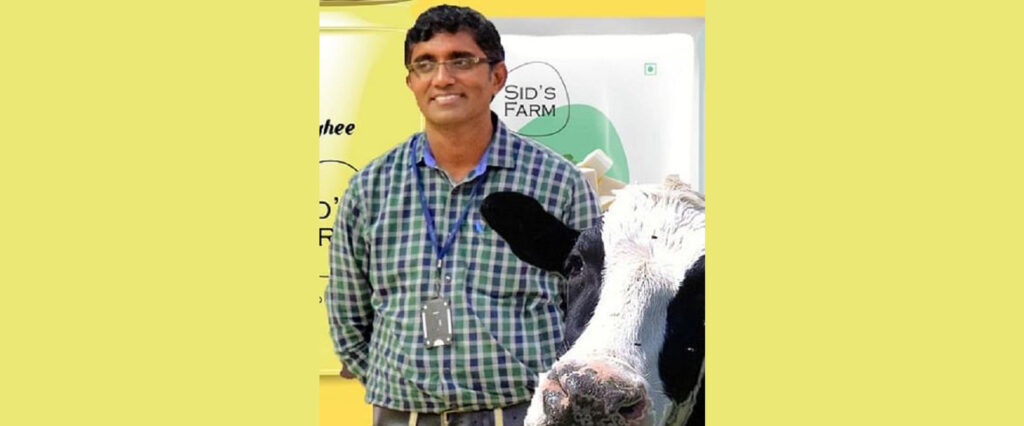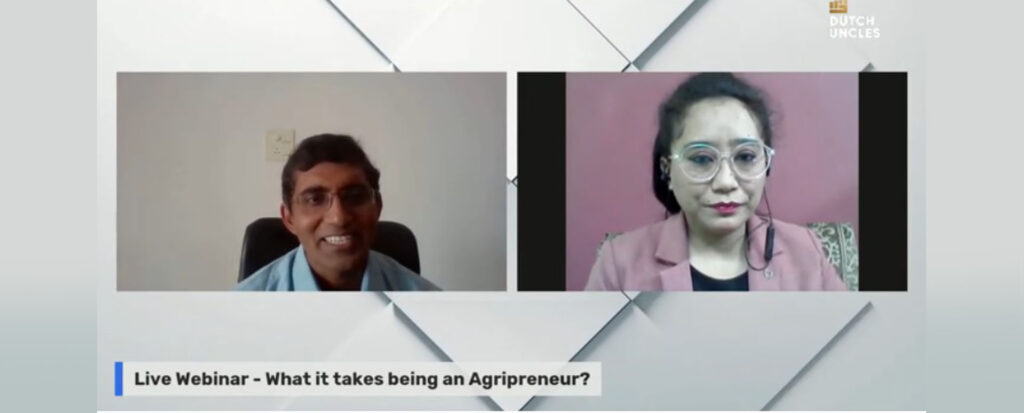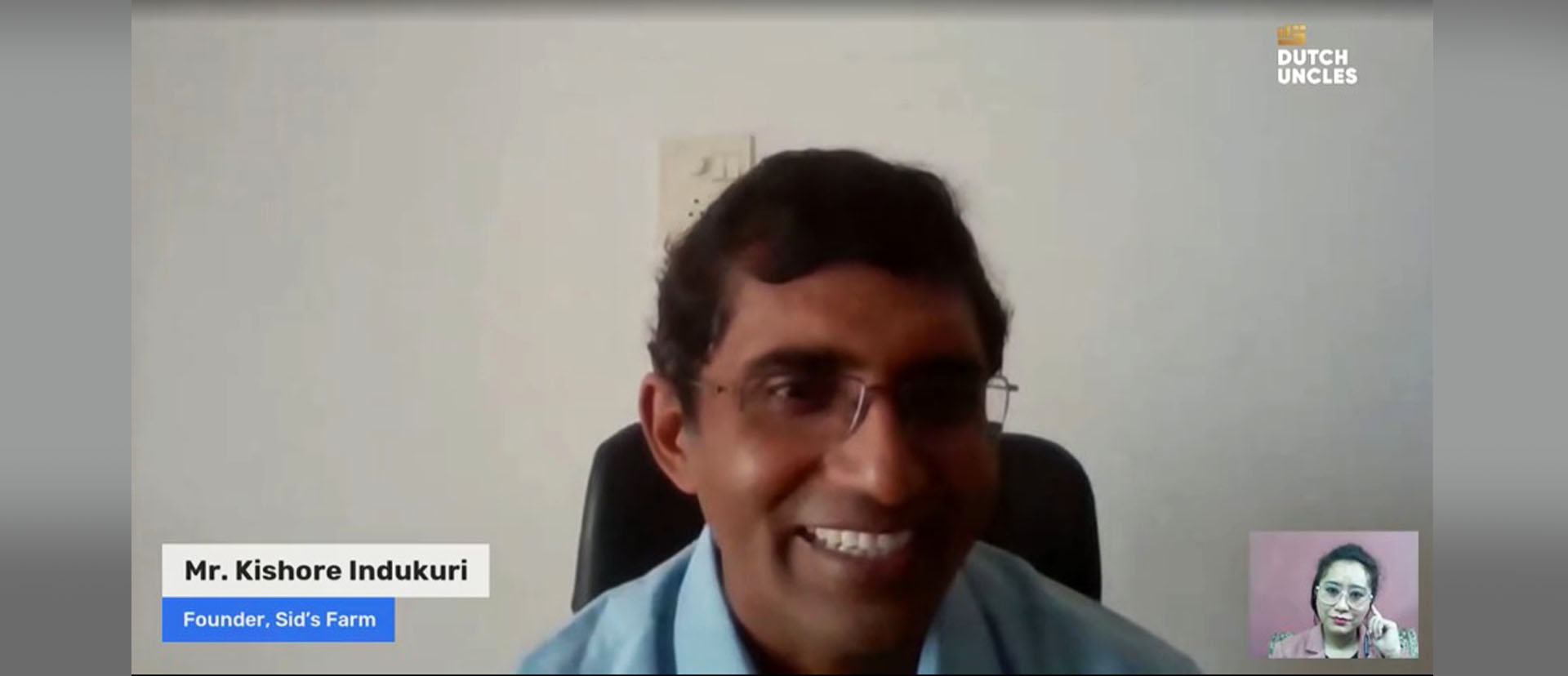How is your phone doing? Has the phone call stopped ringing and has the messages stopped flooding?
First of all, Sapna, it’s been a crazy week. You know, we are grateful for all the thank you messages that we received, we are very happy for it. I’m personally not able to reply to all of them, but I am trying to reply to most of them. I would be calling back and reverting over the course of the next few weeks.
Heartiest congratulations for your hard work being recognized.
Thank you. Yes, it’s a great feeling getting recognized, but we still have a lot of work to do and a long way to go, we have just started.
How did your entrepreneur journey start?
Our journey started back in 2012. When I moved back to India from the US. I really liked spending time in a field or a farm, so I thought why not do something in agriculture and that is how it started. I started talking and meeting people, met a few consultants, pondered on vegetable farming, contract farming, and doing vegetables. And as we started researching, we saw there was a need for pure unadulterated milk and there were not many players selling pure, unadulterated milk and I thought I would be able to do so, that’s how my journey started.
‘‘
For those specifically interested in dairy farming, even before you buy your first set of calves, figure out - is there a market?
What should be the first thing an Agripreneur should look at? Is it marketing because if we look at your marketing strategy, the foundation is absolutely strong?
Yes, Sapna you got it right. I wanted to emphasize the importance of marketing today. We had not done much research initially, when I started the farm. The idea was to put together a small business model in excel sheet. We thought we would be able to sell milk at Rs 40 a litre and make money. The business model was great, it had 100% return on investment. We went ahead and bought some cows from Coimbatore, and hired a few people to help us with milking the cows and a person to look after the farm. We then started selling the milk – Rs 13 is what we got, we were shocked, as Rs. 30 is what our cost was. It took 6 months for us to stabilize all aspects of production and we made sure we produced at least 50 litres of milk in a day. Once we had that 50 litres, we decided to sell it directly to the consumer, and that is what laid the foundation. For us, not having surplus funds acted as a boon. Or else we would be happy selling milk in bulk and maybe we would never explore the option of selling our produce directly. We got a few flyers printed saying that we do pure milk and went to houses, apartments, complexes, and we were scouting the city. On weekends we would be a part of apartment community talks and spoke about our milk, and ask customers to taste our milk.
My advice to the entrepreneurs who aspire to make it in Agritech is, it does not matter if you are in Tier I or Tier II, you have to first understand where your market is and how you will sell. For those specifically interested in dairy farming, even before you buy your first set of calves, figure out – is there a market?
I’m sure India has that market today and I am pretty confident that you can sell your milk anywhere, but it has to have some extra value. For us it was purity, our first core principle has always been – we will be an honest business and will never compromise on our value of purity. We’ll have to do whatever it takes, however pick your core principle and be honest to it. You have to let your customers know about what your core principle is. You have to speak with your customer’s and let them know what is in your mind, if you need help from them right at the start you have to let them know. For us, we told them our price point and why we needed to keep that price as of then, they understood and always supported us.
In the last one year I have come across several people who want to start a farm business. I tell them first figure out if you can work with one farmer first. If you know 10 farmers, speak with them and see if a partnership or association works. Then you can bring the standards of the milk as to the desired plan and then see if you can market the produce.
If you could tell us more about your experience as to how you created talking points with your customers and initiated direct selling?
Great question. Connecting with our customer base gives you a complete pulse of the customer and the market. You know, what price the customer can afford. There are different price points that you can look at. For example, buffalo milk in most towns in India is set at Rs. 70 per litre however cow milk has a price point in each town. See what the price point is in the area or location you intend to sell. Once you have decided the price point you have to start building customers. Start by directly speaking and interacting with them, it could be in the bank manager, school, talk to parents. Overall whatever it takes, you can speak with anyone who you know can be your customer and will agree to your price point.
You can pitch sampling of your milk, and also customise and create dairy baskets – it may have milk, eggs, cheese, vegetables cleaned up and sliced. A Tier II or Tier III market may want this for sure. What extra value can you give which will make people try your product. However, before you explore your ideas you have to figure out the market.

What was the differentiator to your business?
Our differentiator has always been being innovative, transparent and honest. We have always thrown open our business to our customers. Before the pandemic one of the things we did at the farm every Saturday was an open house. Customers could walk into our facility, and see the milking of a cow, our grass growing operations. We gave them a tour of our processing facility; we even gave them access to our laboratory where all tests are conducted. And hence we confidently say that our milk is 100% pure, free of preservatives, antibiotics and hormones. We invited schools and students for this farm tour. This was our way of trying to win the trust of our customers.
Your business project looks well researched, well organized, overall, it’s been done in bits and pieces, as a sequential flow model, if you could tell us about it?
We started with 20 cows with the initial idea to have a dairy farm, we never thought of anything else. We thought we will have few people who can milk our cows and we will sell the milk. Very soon we figured out that we had to sell this milk directly to the customer. We set up logistics for it, we bought an auto, and we started milking at 4 am, the milk would go out at 5.30 am and by 6.30 am it would reach the city. Between 6.30 am-7.30 am, we finished delivering milk because it was a small quantity. As the demand for our milk increased through word of mouth, we started waking up as early as 3.30 am. This was not making sense, as we had to keep our cows awake too. So, we tried to increase the speed of packaging, we were packing it ourselves to save the packaging cost. But soon we went from a hand packaging machine to an automatic packaging machine. This being done we were supplying milk 365 days, twice daily. This was not meeting our required production plan though we were doing only raw milk then. This was when we felt it’s time to set up a small pasteurization facility. As the demand started increasing, we only then started to build a formal distribution system. Once our product was validated it is then that I decided we can now buy our own piece of land, till then we were operating from a leased facility.
This is advice, please do not invest in big fancy sheds or land in the beginning, figure out your business model, your marketing strategy and only then invest in large infrastructure. In 2018 we moved into the new facility, since then we have been educating and spending time talking to our customers, that is how we were able to grow the business.
The next step was testing. How do you know that your milk is free from urea sugar, salt, glucose, hydrogen peroxide, so we had to figure out how to test milk? Initially, we started with kits that were available in the market, we were buying each kit for Rs. 4000 which was used in a day. So, we decided we have to start testing on our own too, and we did. Today we do over 2000 tests daily on our milk.
‘‘
Building a business takes time, you need to invest for the long term. But, if you put your energy and heart and mind integrated, it will definitely work.
Understanding the pulse of the customer is the crux of any business, when was it exactly that you understood the pulse of your customers?
The great thing direct to customer marketing is you get customer feedback instantaneously. So, if a customer does not like your milk he/she can call you and let you know. That is a great thing about serving your milk directly to customers. We’ve always been fortunate as our customers gave us immediate feedback and we started with better processes and systems, and the right kind of facilities to make it happen.
How can we bring in a robust approach to farm, dairy and allied services?
We have to think differently, how can we add value to the customer. I think there is a lot of opportunity in agriculture and allied services where entrepreneurs can make a big difference, to add to the benefit there is technology now.
When did you bring technology to the business?
So when we figured out that our manual systems were breaking, we knew we were six months late. This is when technology came into picture. We felt we needed automation and hence allowed technology to help us make things easier and sorted.
What would be the takeaways for start-ups?
What is the problem that you’re trying to solve for the customer? Is the customer willing to pay for that problem? Figure that problem, then provide the solution. What is going to be your marketing strategy, whether you would farm yourself or go for bulk, figure out what works for you. If you have a great arrangement with somebody that would pick up all your milk or all your produce in bulk, you can do that as well.
Do you think the oldest marketing model that is word of mouth worked for you?
Definitely, there are customers who have been with us for the past eight years since the very beginning. And they continue to talk about our milk with others. We are very grateful to them and that is how we are growing.
Audience question – How much money should I start with?
Typically, today a cow costs anywhere from Rs. 50,000 to Rs. 60,000 in southern part of India, in northern part of India, I’m not exactly sure about the prices, but they are probably in the same range. Buffaloes cost anywhere from Rs. 80,000 to Rs. 1,00,000. So, depending on what you have planned on infrastructure, equipment, man power, whatever you do, try to do it at a low cost. Your main cost should be the cost of animals to begin with. Next figure out the marketing part, if that is done, you will be able to sell.
Audience question – Can India be number one with its produce?
I will talk about milk specifically, I think India produces the best milk in the world. The reason I say that is because our farmers are small landholding farmers, and such farmers take good care of their cows. This is the model and I think India should have, owning small farms rather than owning large ones. It is better to own hundred animals at the maximum at one time. And if you can work with small farmers, you can be sure to make the produce a great one.
Audience question – Have you ever faced losses?
We have been making money for the past two to three years only. It has always been at a loss, before that. It has been a one way flow of money. One reason being, to this day, whatever little money we make, we continue to invest in the business. So, the answer to it is, it takes time, building a business takes time, you need to invest for the long term. But, if you put your energy and heart and mind integrated, it will definitely work.
Audience question – Do you plan to go retail?
We are already in the retail segment in Hyderabad, we are selling in a few stores in the city. Our predominant sale is through direct to consumer, we sell through our app. We are also in retail stores; we are present in about sixty-seventy stores.
Audience question – What advice would you give on indirect selling?
Indirect seller is one who is not producing milk, but taking it from a farmer and selling it to the end customer or to a bulk buyer. You can be an indirect seller if you are getting that margin. It can be Rs 4 or Rs 5, you need that margin. If this arrangement works between you and the farmer, why not. You can provide a value-added service, test it as a model and you can try if this works for you.
Audience question – Do you accept new entrepreneurs to come and learn from you?
We do, I mean, we do programmes. You have excuse us for another few months till COVID-19 subsides.
We would be more than happy to guide you. We can definitely plan and start running dairy farming courses. Few years ago, we conducted a course for a small group, most of them were techies, they spent 8-9 hours at the farm, they closely observed and saw how we do dairy farming.
Audience question – Do you cultivate or grow the fodder and how do you manage its high price?
It’s a great question. If there are a lot of questions on dairy farming, we will do another webinar, where we will talk about what is important in dairy farming. Now coming to the question, the first thing is – grass. Our farm is only three and a half acres but we lease 50 acres of land close by and the reason is because we always want to have enough stock of green fodder. During the rainy season, we plant as much as possible, and we store grass, you need to make sure that you grow your grass at the lowest cost possible. This is one way you ensure the cost of grass does not escalate. So, before you start your dairy farm, plant your grass, get your fodder ready and only then bring in the animals. Do try to reduce your production costs as much as possible. Also, there is a lot of new technology coming in with what you can do with your cow dung. For instance, we recently purchased a cow dung lock machine which through cow dung makes wooden locks, you can also sell your cow dung at a fair price. There’s a lot that can be done and definitely fodder is important for the cost of your business; if you can make it as low as possible, your dairy farm will be successful.





